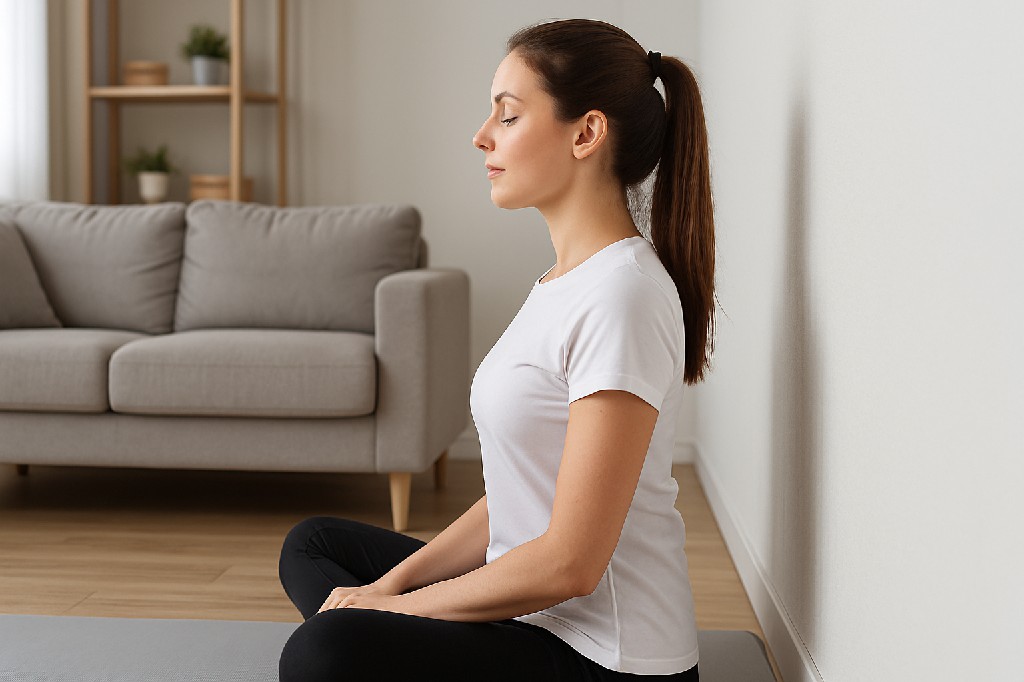Natural Posture Correction: 7 Easy Fixes You Can Do at Home
Poor posture has become a silent epidemic in today’s digital world. With long hours at desks, constant phone use, and minimal movement, it’s no surprise that our bodies are suffering. Fortunately, natural posture correction offers a safe, cost-free way to restore alignment and ease tension. In this article, we’ll walk you through seven simple, science-backed fixes you can try at home, no devices or expensive equipment needed.

1. Morning Stretching for Natural Posture Correction
One of the easiest ways to begin improving your posture is by starting your day with a quick stretching routine. As you sleep, your muscles often stiffen, particularly in your neck and back. Stretching each morning helps wake up your body, increase circulation, and restore balance to your spine.
Moreover, certain stretches target the exact areas most affected by poor posture, such as the chest, shoulders, and hip flexors. For example, a doorway chest stretch or gentle backbend can open up your front body and undo the effects of slouching.
Transition tip: Even if you only have five minutes, consistent daily stretching can make a long-term difference.
2. Set Up a Natural Posture Correction-Friendly Workstation
Let’s face it: many of us spend hours a day sitting. That’s why your desk setup plays a crucial role in your spinal health. To encourage natural posture correction, you must adjust your environment to support a neutral spine.
Here are a few quick tweaks:
- Keep your screen at eye level to avoid leaning forward.
- Use a chair with lumbar support or add a small rolled towel to support your lower back.
- Sit with both feet flat on the ground and your knees at a 90° angle.
Additionally, remember to check in with your posture regularly throughout the day. Setting a reminder every hour can help build awareness until proper alignment becomes a habit.
3. Practice Natural Posture Correction with Wall Alignment
A simple but powerful technique for natural posture correction is the “wall test.” Standing against a wall helps your body naturally find proper alignment, without needing to overthink it.
Here’s how to do it:
- Stand with your back against a wall, heels about 2 inches away.
- Touch your buttocks, shoulder blades, and back of the head to the wall.
- There should be a small gap at your lower back.
Maintain this position for 30–60 seconds daily. This practice builds muscle memory and teaches your body how good posture should feel.
Transition phrase: As time goes on, your body will begin to hold this posture even without the wall’s help.
4. Strengthen Core Muscles for Natural Posture Correction
Good posture starts from the inside out. A strong core stabilizes your spine and supports the upper body, making slouching less likely.
You don’t need intense workouts to strengthen your core. In fact, gentle movements like planks, bridges, or bird-dog exercises done a few times a week can bring noticeable results.
Because the core includes muscles in the abdomen, lower back, and pelvic area, a balanced workout plan is key. Make sure to include both front and back muscle groups in your routine.
Pro tip: Try combining breathwork with core activation exercises to improve both posture and mental focus.
5. Focus on Breathing to Support Natural Posture Correction
Most people don’t realize that their breathing habits affect posture, and vice versa. Shallow chest breathing often goes hand-in-hand with slouched shoulders. On the other hand, natural posture correction helps open the diaphragm, making it easier to breathe deeply and calmly.
To retrain your breath:
- Sit or stand tall.
- Place one hand on your belly and one on your chest.
- Inhale slowly through your nose, allowing your belly to expand.
- Exhale gently through your mouth.
Importantly, this not only improves oxygen flow but also activates core muscles, further supporting alignment.
Breathing exercises are subtle but powerful. Done regularly, they help lower stress, release tension, and promote natural posture throughout the day.
6. Walk Mindfully for Full-Body Alignment
Walking is something we do daily, but few people walk with correct posture. The next time you go for a walk, treat it as a natural posture correction exercise.
Here’s what to focus on:
- Keep your head lifted, eyes forward.
- Relax your shoulders, letting them fall away from your ears.
- Swing your arms naturally, in sync with your steps.
- Engage your core and roll through each foot from heel to toe.
Furthermore, avoid distractions like texting while walking. By staying present, you can train your body to move with better alignment, even in daily life.
7. Build a Daily Routine for Natural Posture Correction
Last but not least, the most effective strategy for long-term success is consistency. Creating a natural posture correction routine, even just 10–15 minutes a day, helps you progress without stress or confusion.
A sample daily schedule might look like this:
- Morning (5 mins): Light stretch + 5 deep belly breaths
- Midday (5 mins): Wall alignment + short walk
- Evening (5 mins): Core-strengthening plank + bedtime stretch
Consequently, making posture work part of your lifestyle ensures results that last. You don’t need fancy tools or hours in the gym. Just your body, your awareness, and a bit of discipline.
🌿 Final Thoughts on Natural Posture Correction
Correcting your posture doesn’t have to be complicated or expensive. By taking small, consistent steps, stretching, strengthening, and adjusting how you sit and move, you’ll begin to feel lighter, taller, and more energized. The power of natural posture correction lies in its simplicity: your body wants to align itself when given the chance.
Start today, and in just a few weeks, you’ll likely notice less tension, better breathing, and a stronger sense of physical confidence.
✅ Summary Checklist
|
Fix |
Description |
|
✅ Stretch Daily |
Release tension and improve flexibility |
|
✅ Adjust Desk Setup |
Support your spine during work |
|
✅ Use Wall Alignment |
Train your body to stand tall |
|
✅ Strengthen Core |
Build internal support muscles |
|
✅ Breathe Properly |
Improve oxygen flow and muscle control |
|
✅ Walk Mindfully |
Reinforce alignment with movement |
|
✅ Create a Routine |
Make good posture a habit |
📌 Bonus Tip
Track your progress weekly by taking a photo or journaling how you feel. Often, subtle improvements go unnoticed, but over time, you’ll be amazed by how your posture and confidence evolve.
